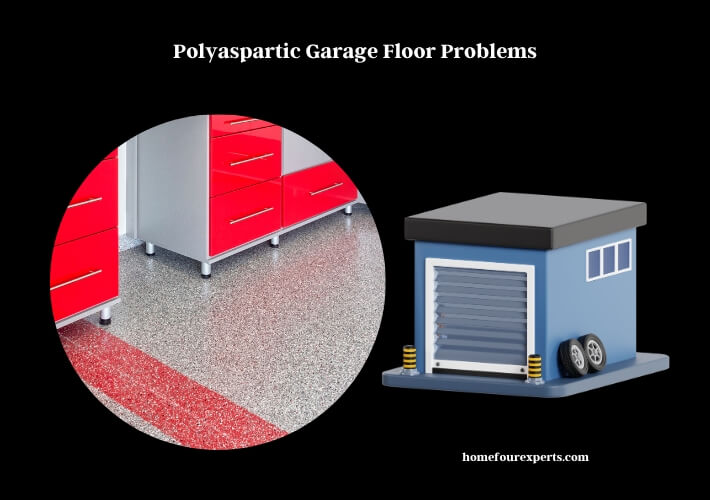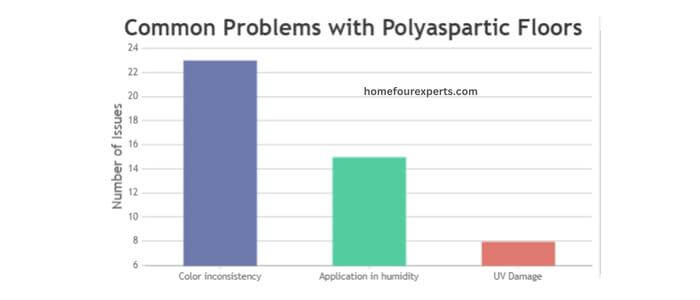Published on: September 12, 2022
Written by Eric Devin / Fact-checked by David Rowan
Polyaspartic garage floors have gained recognition for their durability and rapid curing times. But like every product, they come with their own set of challenges.
Polyaspartic floor coatings are often chosen for their fast curing properties and long-lasting results. These coatings are especially popular for garage floors, as they resist chemicals, abrasions, and UV rays. Comparatively, polyaspartic tends to be more expensive than epoxy. In the debate between polyaspartic vs epoxy, the former boasts quicker installation and greater UV stability, whereas epoxy might be more budget-friendly.
One factor to consider is where to buy polyaspartic floor coating. Authentic and quality products are crucial to ensure longevity and optimum performance. Many vendors offer a polyaspartic garage floor kit, which can be an excellent option for those considering a DIY approach. Still, for those who are not familiar with floor coating application, hiring a professional might be a wise decision, as the process requires precision and the right equipment.

While both polyurea and polyaspartic are known for their resilience and rapid curing times, it’s essential to differentiate them. Polyaspartic is a type of polyurea, but not all polyurea is polyaspartic. The pros and cons of polyaspartic primarily revolve around its cost, installation time, and longevity.
Considering the benefits and potential challenges of polyaspartic floor coating, it’s worth considering whether this is the right choice for your garage. For a deeper insight into polyaspartic floor coatings and more details, we invite you to read the detailed article below.
Polyaspartic Garage Floor Problems: A Detailed Analysis
You’ve likely heard about the wonders of polyaspartic garage floors, right? They’re the talk of the town for many homeowners and builders. But let’s not get ahead of ourselves. While they offer several benefits, there are also some challenges to be aware of. Let’s break it down.
Why Polyaspartic Garage Floors are Popular
Quick curing properties
Imagine painting your nails and having them dry in a flash. That’s the magic of polyaspartic floors. Their rapid curing properties mean you can walk on your newly coated garage floor sooner than you would with other coatings.
Resistance against chemicals, abrasions, UV rays
Ever spilled something on the floor and panicked? With polyaspartic, that worry is almost gone. This material stands tall against the usual suspects – chemicals, scratches, and even the relentless sun.
Cost Analysis of Polyaspartic Flooring
Did you think all good things come without a price tag? Let’s take a look at the numbers.
Average Price Range of Polyaspartic Flooring per Square Foot
| Size (Square Foot) | Cost ($) |
| 100 | 700 |
| 200 | 1300 |
| 300 | 1900 |
Factors influencing the cost
Like most things in life, several factors can sway the cost of polyaspartic flooring. This includes floor prep work, region, and any custom designs or colors you fancy.
Comparison with Other Floor Coatings
Choosing a floor coating can feel like being in a candy store. So many choices! Let’s look at how polyaspartic stacks up against its competition.
Polyaspartic vs Epoxy: Pros and Cons
Both have their strengths. Polyaspartic dries quicker and hates UV rays less, while epoxy might not burn a hole in your pocket as deep.
Polyurea vs Polyaspartic: Distinct Features and Benefits
Think of them as siblings. Polyaspartic is a subtype of polyurea. While they share some traits, polyaspartic often tends to cure faster.
Common Challenges Faced
Issues during application
It’s not always sunshine and rainbows. Sometimes, if not mixed correctly or applied in the wrong conditions, things can go south.
Environmental factors affecting performance
Mother Nature can be fussy. High humidity? Polyaspartic might not settle well. Too cold? The cure rate might slow down.
Maintenance and longevity concerns
With time, even the best things need a touch-up. Depending on use and maintenance, your perfect floor might show signs of wear.
Detailed Breakdown of Polyaspartic Issues
Ever wondered what the most common hiccups are?
Bar Chart: Frequency of Common Problems faced by Homeowners with Polyaspartic Floors

Color inconsistency and yellowing
Remember trying to get that pancake just the right shade of golden brown? With polyaspartic, sometimes the color doesn’t set as expected.
Difficulty in application on humid days
Imagine trying to fry an egg on the sidewalk on a hot day. That’s polyaspartic on a humid day, not quite setting right.
Cost Implications of Polyaspartic Flooring Challenges
It’s like going out to eat and forgetting to factor in the tip. The extra costs can sneak up on you.
Chart: Distribution of Additional Expenses due to Polyaspartic Floor Issues

Costs of repairs and touch-ups
Little things add up. A nick here, a scratch there, and before you know it, you’re calling in the professionals.
Replacement expenditures
And in some cases, a touch-up just won’t do. It’s like trying to patch up that old pair of jeans – sometimes, you need a new pair.
DIY vs Professional Installation
Should you roll up your sleeves or call in the cavalry?
Challenges of DIY application
DIY can feel like assembling that complicated IKEA furniture. Sure, you can do it, but it might take longer and might not look like the picture.
Benefits of professional installations
Getting the experts in is like having a personal chef. They have the tools, the know-how, and can whip up perfection while you sit back.
Mitigation Measures and Best Practices
Pre-application floor checks
You wouldn’t bake on a dirty oven tray, would you? Cleaning and checking the floor before application can save a ton of heartache later.
Right tools for application
It’s like trying to cut a steak with a butter knife. The right tools make the job smoother and the results better.
Environmental considerations
Just like you wouldn’t wear a fur coat in summer, applying polyaspartic needs the right conditions.
Polyaspartic Floor Lifespan Calculator
Ever wondered how long your shiny new floor will last? Here’s a handy calculator to give you a ballpark figure.
FAQs
What Is the Difference Between Polyurea and Polyaspartic?
Polyurea is a type of elastomer derived from the reaction of an isocyanate component and a synthetic resin blend component. Polyaspartic, on the other hand, is an aliphatic polyurea. The key difference lies in their application and drying time; polyaspartics dry faster than traditional polyurea.
How Long Does Polyaspartic Take to Dry?
Typically, polyaspartic coatings can dry within a few hours. However, the exact drying time might vary based on environmental conditions and the specific product used. It’s best to check the manufacturer’s recommendations.
How Long Does Polyaspartic Last?
Polyaspartic coatings can last for several years, often surpassing a decade with proper maintenance. Their longevity depends on factors like the quality of installation, environmental conditions, and the level of traffic on the floor.
Can You Buy Polyaspartic Floor Coating?
Yes, polyaspartic floor coatings are available at various specialty retailers, home improvement stores, and online platforms. Ensure you choose a trusted brand for the best results.
Why Is Polyaspartic Flooring Preferred Over Epoxy?
Polyaspartic flooring tends to dry faster and is more UV stable compared to epoxy. This means it won’t yellow over time when exposed to sunlight. Plus, it’s often considered more flexible and can withstand temperature fluctuations better than epoxy.
Does Polyaspartic Coating Cost More than Epoxy?
In many instances, polyaspartic coatings might be pricier than epoxy upfront. The exact cost difference depends on the brand, quality, and other factors. Nonetheless, considering its durability and longer lifespan, many find the investment worthwhile.
Are Polyurea and Polyaspartic Garage Floor Coatings the Same?
While they’re closely related, they’re not the same. Polyaspartic is a subset of polyurea. Both offer quick curing times and strong durability, but polyaspartic has a few distinctive characteristics, especially in terms of its application properties.
Polyaspartic garage floors? They’re pretty great, but like all things, they have their quirks. By knowing what to expect and how to handle them, you can ensure your garage remains the envy of the neighborhood. Ready to make an informed choice? We thought so.
Was our blog useful to you? Feel free to check out:
- Revealing Issues: Problems with Aeratis Porch Flooring
- Troubleshooting Earthen Floor Problems
- Troubleshooting In-Floor Pool Cleaning System Issues
- Can You Epoxy a Cracked Garage Floor: A Step-by-Step Guide
- Do I Need Flood Insurance for a Second Floor Condo? An In-Depth Look
- Troubleshooting Guide: AC Blowing Hot Air After Battery Disconnect
- Untangling the Complexity of CeDUR Roofing Problems
About This Writer

Hi, I am Eric Devin and I am a professional interior architect. Since childhood, I've always enjoyed DIY projects! And, I have loved to solve simple household problems using essential tools and equipment. I have also acquired a lot of information about basic household tools settings by working with contractors.